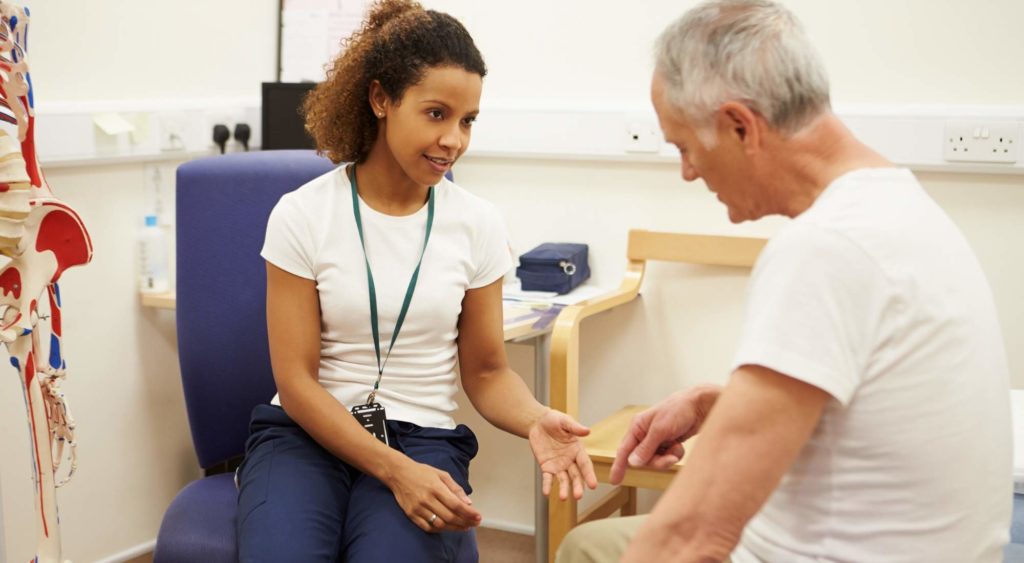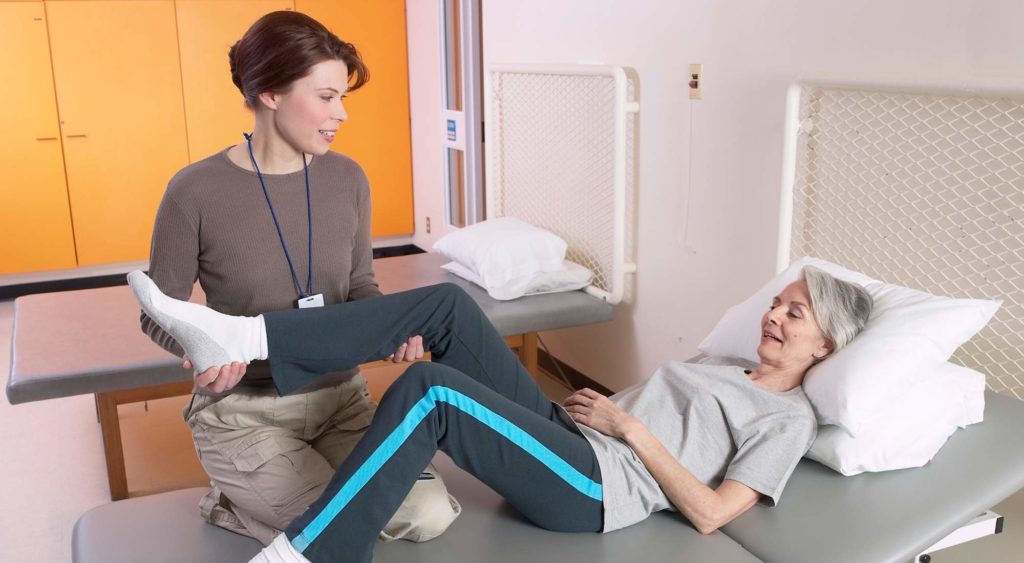
If it’s your first time heading to physical therapy, it can be a little intimidating to figure out what to wear.
You might be wondering,
“What is my appointment going to be like?”
Or
“What is appropriate to wear? Does my outfit matter?”
And it’s true, the unknowns can be frustrating.
But what should you wear to physical therapy?
In this guide we’re answering all there is to know about what and what not to wear to your physical therapy appointments and how choosing the right outfit is beneficial to your care.
Contents
- Why Does What You Wear Matter?
- What Do You Wear To Physical Therapy?
- Examples Of What To Wear To Physical Therapy
- Wear Clothing That Allows You To Move Freely
- Wear Clothing That You’re Comfortable In
- If You Have A Lower Body Injury
Why Does What You Wear Matter?
What do you wear to physical therapy appointments? Does it really matter what you wear?
Yes, it does.
Wearing the wrong types of clothing to your physical therapy appointments can actually have negative effects on your physical therapist’s abilities to treat you.
Terry’s story, for example, shows why proper attire is ideal for physical therapy. Let’s take a look:
Terry recently underwent knee surgery. Now, she has to go to physical therapy multiple times a week to help decrease the pain and increase her mobility.
For her first day of physical therapy, Terry showed up to her appointment in tight-fitting leggings, and slip-on shoes. She had been running errands all morning prior to her appointment and didn’t think anything of her outfit.
When she arrived at her appointment, she quickly realized that her tight-fitting leggings were not ideal.
Her physical therapist needed to examine her knee — view it, manually manipulate it, etc. — and she couldn’t move her leggings higher than above her calf muscle.
Now, both Terry and her therapist are trying to work around her clothing and make it through the first round of physical therapy successfully. Talk about frustrating.
So, what do you wear to physical therapy instead?

What Do You Wear To Physical Therapy?
When it comes to choosing an appropriate outfit for your physical therapy appointments there are a few basic things to keep in mind.
The clothing you wear may have to do with the specific injury or body part that is being treated during your therapy appointment.
Although some of these may differ based on the body part you’re focusing on — there are generally a few safety guidelines to follow.
What should you think about before deciding on what to wear?
Consider these three factors:
- What is your range-of-motion like in the clothing? Are you able to move around easily?
- Can your doctor or physical therapist easily access or see the affected areas?
- How comfortable are you in the clothing you’ve decided on? Will you be able to do exercises in them? Can you move around or stretch comfortably?
It is especially important that you avoid any tight-fitting, restrictive clothing.
What should you wear to physical therapy?
Proper physical therapy attire includes:
- Loose-fitting tank tops
- Loose t-shirts
- Athletic shorts
- Workout pants/training pants — pants with a loose or elastic waistband.
- Proper footwear — we’ll cover this in a little bit.
- Proper undergarments — sports bras, etc.
One way to figure out if you’re wearing the proper attire is to ask yourself if you’d wear what you have on to the gym — you wouldn’t wear business casual clothes, or jeans, to workout.
If you have longer hair, consider bringing something to pull your hair back.
Proper Footwear
Comfort is key — but proper support is also vital.
Always, always wear socks and sneakers to your physical therapy appointment — unless you are unable to.
Supportive athletic sneakers, or tennis shoes, are your best options.
Stay away from wearing sandals, heels, or slip-on shoes (unless absolutely necessary).
Wearing non-skid shoes is important during your physical therapy treatment.
You may be doing a number of different exercises that require you to stand on surfaces that you are not used to.
Slip-on shoes, open-toed shoes, and shoes that do not have non-skid soles can put you at risk for an injury.
Avoiding an injury will help us all achieve our priority: helping you heal. Always wear appropriate footwear to any physical therapy appointment.
Clean Clothes
To provide the safest and most thorough care, we have to commit to a clean environment and do all that we can to practice infection control procedures.
In our facilities, we do all we can to prevent the spread of infections like MRSA, SARS, etc.
E. Coli and salmonella can live on surfaces for days, including your clothing.
So, please help us by committing to cleanliness when coming to your physical therapy appointment.
Avoid wearing scrubs, work clothes, gym clothes you’ve worn previously without being washed to physical therapy appointments.
If you are coming straight from work, or the gym, practice good hygiene and bring a set of clean clothes with you for your appointment.
What Not To Wear to Physical Therapy
What should you avoid wearing to your physical therapy appointment? Here are a few suggestions:
- Dress clothing or work clothing. If you are coming straight from work, bring extra clothes with you.
- Previously worn clothing.
- Dress shoes, open-toed shoes, or boots.
- Excessive jewelry — necklaces, bracelets, earrings, etc.

Examples Of What To Wear To Physical Therapy
The ideal physical therapy outfit will allow your doctor or physical therapist to see what’s going on without your clothing getting in the way.
But what does that actually mean?
Ask yourself these questions:
- Can I perform basic exercises in this outfit without being restricted or uncomfortable?
- Can my doctor easily access the affected area?
Wear Clothing That Allows You To Move Freely
Be prepared to move around a lot.
In order for your physical therapist to help properly treat your ailment, he or she has to be able to see how everything is moving.
You’ll likely be exercising and performing other motor skills, so the clothes you’re wearing should be unrestrictive.
Sports attire — like athletic shorts, pants, and tops, are ideal for physical therapy.
If you’re in physical therapy for rehabilitation after back surgery for example, like Terry in the above story, a fitted sweater would not be ideal.
Wear Clothing That You’re Comfortable In
We’ve said it before and we’ll say it again. Comfort is key. Especially during your physical therapy appointments.
No one wants to be moving around excessively in uncomfortable clothing.
Layering clothing is a great way for you to remain comfortable during your physical therapy session — you’ll be exercising, so removing layers as you workout may be necessary for your own comfort.

If you have an upper-body injury that has brought you to a physical therapist, you’ll want to wear clothing that allows easy access to the affected body part.
Whether you’re going to physical therapy for a shoulder, back, neck, or any other upper-body injury — it’s important to consider how the clothing you choose will affect how comfortable you are and how your physical therapist can correctly do his or her job.
Wear Loose-Fitting Clothing
Loose-fitting tank tops, long-sleeve or short-sleeve shirts, etc. make physical therapy appointments easier for both you and your physical therapist.
You want to be able to move the clothing around without any discomfort.
That being said, consider what range-of-motion exercises you may be doing at your appointment, you don’t want to accidentally wear an outfit that might reveal more than you’re comfortable with.
Women should wear sports bras with an open back, some therapists even recommend bathing suit tops in place of bras.
If You Have A Lower Body Injury
If you are in physical therapy for a lower-body injury, it’s important that you wear clothing that can be easily rolled up to at least the knee. Some of the best clothing options for lower body physical therapy treatments include:
- Yoga pants
- Loose-fitting shorts
- Skorts
- Sweat pants
Avoid tight clothing or clothing that does not allow for easy movement such as:
- Jeans
- Joggers
- Skirts
- Dress Leggings
- Dresses
Wear Clothing That Allows For Easy Access To Treatment Area
Terry’s physical therapist, for example, needed to be able to see her knee.
Her snug leggings did not make it easy for her to show her physical therapist the affected area, and it was probably uncomfortable for Terry to practice the new strength training exercises during the session.
Had she worn loose-fitting pants, or athletic shorts, her physical therapist could have spent more time assisting her with her treatment plan and less time trying to work around her clothing.
Are you looking for a physical therapist in Orange County?
In Motion O.C. offers free consultations with top-rated professionals. Our physical therapists are committed to providing the safest, highest quality care.
Our mission is to give hope, healing, confidence, and joy to others — even if that starts with helping you prepare for your physical therapy appointment before you’ve stepped foot in our doors.



